LEME UPDATES
July 2007
LEME Paper voted one of best four at SAGEEP
Dr Andrew Fitzpatrick's paper "Mapping Salt-loads of the Murray River, Australia, using airborne and in-river electromagnetic methods" was one of the best at the Symposium on the Application of Geophysics to Engineering and Environmental Problems, held April 07 in Denver, Colardo. Andrew is from CSIRO Exploration and Mining and his attendance was co-sponsored by CSIRO and LEME.
It is very encouraging to see LEME science getting recognition i=on the international stage which reflects well on the Program 4 team's work. Andrew has been invoted to present the same paper at the Near Surface 2007, 13th Eurpopean Meeting of Environmental and Engineering Geophysics Conference, Sept 07.
Download Abstract. Symposium Proceedings available from
http://www.eegs.org/pdf_files/publication_order_form.pdf
August 2006
Dr Ravi Anand wins 2006 Butt Smith Medal
CSIRO Exploration and Mining Senior Principal Research Scientist Dr Ravi Anand has won the Butt Smith Medal for his outstanding contribution to geoscientific research.

The award acknowledges Dr Anand's long-term dedication and excellence in the development of geochemical mineral exploration techniques for Australia 's deeply weathered landscapes.
Awarded by CRC LEME and CSIRO Exploration and Mining, the Butt Smith Medal recognises "outstanding and sustained contributions linking regolith science to exploration in Australia"
The announcement of the Butt Smith Medal was made at the 2006 CRC LEME Minerals Exploration Seminar held on Friday, 11 August.
Further information about the Butt Smith Medal and the geoscience research contributions made by Dr Ravi Anand.
LEME Minerals Exploration Seminar well received
The latest research developments within CRC LEME aimed at assisting the Australian mineral exploration industry find new mineral deposits was presented at the 2006 LEME Minerals Exploration Seminar held on Friday, 11 August.
More than 100 representatives from exploration companies, big and small, as well as State Government Agencies, attended the Seminar to hear LEME researchers discuss their latest work to find new geochemical and geophysical ways to locate mineralisation in areas of regolith cover.
Topics on the day included the inside story on the making of the Northern Territory Map and Atlas of Regolith Materials, a discussion on regional geochemical trends in laterites found in the south-western part of the Yilgarn Craton, and the potential of the humble spinifex plant in becoming a new medium to detect geochemical anomalies above mineralisation.
The response to the presentations and feedback received by LEME staff were both very encouraging. The high degree of interest shown in LEME research was also reflected by the large number of Centre publication purchases made on the day.
Abstracts associated with Seminar presentations topics can be downloaded here:
Humble spinifex could be exploratory key
THE common spinifex plant of Central Australia is proving a good indicator of mineralisation, according to the Cooperative Research Centre for Landscape Environments and Mineral Exploration (LEME).
LEME's research on Tanami Gold's Coyote gold deposit in the Northern Territory's Tanami Desert, which was presented as part of the centre's annual Minerals Exploration Seminar, revealed that spinifex leaves had shown elemental anomalies over known mineralisation.

The use of spinifex leaves as a geochemical sampling medium is one of the many topics under discussion at the seminar, which is designed to showcase new techniques developed by the centre that may aid Australian mineral explorers.
LEME Education and Training program leader Dr Steve Hill, from the University of Adelaide , said Australia was a continent that has undergone extensive weathering, erosion and deposition in many parts.
"Most surface or near surface mineral deposits have been found, mineral explorers now need to find cost-effective ways to find deposits beneath the weathered and transported material known as regolith," Hill said.
As a result, the centre has looked at improving the understanding of the physical, hydrological and biological controls of geochemical dispersion in regolith from mineralised areas.
"Our biogeochemical study of spinifex plant leaves over the Coyote gold deposit is one of the many ways we are doing this," Hill said.
"So far, a study by our PhD student Nathan Reid has shown that spinifex has great potential as a biogeochemical sampling medium throughout Australia , as its roots penetrate deep into the ground and it's common throughout arid Australia ."
The seminar held in Perth on August 11, also featured presentations on how other geochemical anomalies are showing up in vegetation over gold and base metal deposits, as well as breakthroughs. MORE INFORMATION ON THE SEMINAR AND ABSTRACT VOLUME AVAILABLE TO DOWNLOAD [2.7MB]
Enquiries to Sue Game CRC LEME HO : 08 6436 8695 - susan.game@csiro.au
Download Program and Registration form
July 2006
LEME gold research features in the prestigious journal 'Science'
Biomineralization of gold: biofilms on Bacterioform Gold
Authors: Frank Reith, Steve Rogers, Bear McPhail (LEME) and Daryl Webb
The journal highlights Dr Frank Reith's research which led to the discovery of a species of bacteria, Ralstonia metallidurans, that precipitates gold out of solution.
For more information and link to full article in "Science" and Science News Story
LEME STUDENT WINS BEST POSTER AWARD AT AESC

Anna receives her award from Geological Society of Australia President, Andy Gleadow
LEME Adelaide University PhD student Anna Petts has taken out 'Best Student Poster' at the 2006 Australian Earth Science Convention (AESC) in Melbourne July 06
The informative poster entitled 'Nature's Drillers and Geochemical Samplers: Termites and their implications for regolith geochemistry in northern Australia' summarised Anna's PhD project work in determining the potential use of soil biota as a biogeochemical sampling medium and regolith mapping tool in the Tanami Desert, located near the Western Australian and Northern Territory borders.
Anna's ongoing research focuses on the use of termite mounds as regional geochemical indicators and to establish a regolith-framework for estimating the depth of transported cover.
Anna explains: "In the Tanami, termites have been observed tunnelling tens of metres below the surface in the search for groundwater. Some of this material, which can contain anomalous geochemical signatures, is taken back to the mound."
"In effect, this means that mound-building termites, through their digging, undertake similar activities to regional geochemical sampling."
Her field research includes sampling mound material for metal content, regolith-landform mapping, geobotanical analysis. A GIS will be used to incorporate the multivariate data generated by her project.
Anna has already determined a relationship between termitaria density, vegetation assemblages and regolith landforms.
Congratulations Anna!
Anna's award-winning poster can be viewed here: [1MB]
June 2006
BEST PRESENTATION -CASH PRIZE TO LEME STUDENT
2006 Student-Industry-CRC Symposium, 18-23 June, 2006 Gladstone, QLD
The Student-Industry-CRC Symposia was a week where students from different minerals related CRCs could present their work to industry sponsors and other students. There was a lot of inter-CRC networking and discussions with industry partners as well as plant tours to the NRG Powerplant, Gladstone Port Authority, Boyne Aluminium Smelter and the Comalco Alumina Refinery.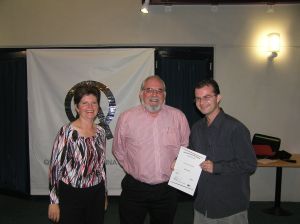
Nathan Reid (CRC LEME PhD student at University of Adelaide) attended the CRC Symposia in Queensland, presenting his work on Biogeochemistry and Geobotany in the Tanami Region. The presentation was very well received by both students and industry attendees leading to a $1000 cash prize for the best student presentation.
Photo shows (L-R) Janine Lay-Rio Tinto, Dan Churach-CRC Sustainable Resource Processing E&T Leader, and Nathan Reid
May 2006
NewProgram 3 Leader Commences
Dr Paul Shand replaces Dr Steve Rogers as our Program 3 Leader: Environmental Applications of Regolith Geoscience. He is based at CSIRO Land and Water in Adelaide. Click here for further information/CV.
LEME Scientist awarded Travel Scholarship.
CRC LEME scientist DR ROB HOUGH has won a $10,000 scholarship to assist him and other team geoscientists to present their work to international audiences.
The scholarship, awarded by the Perth Convention Bureau, was one of three $10,000 scholarships and three conference development awards presented at a ceremony at Council House in early May 06.
Dr Hough, who is based at CSIRO Exploartion and Mining in Perth, hopes to coordinate a bid for Perth to host a major international meeting supported by the world's two leading mineralogical societies, the Mineralogical Society of America and the Mineralogical Society of Great Britian and Ireland.
The 2004 recipient of the Premier's Prize for Early Career Achievement in Science, Dr Hough was also a finalist for the Prime Minister's Prize for the 2005 Physical Scientist of the Year.
April 2006
Launch of LEME Open File Report 196 - Atlas of regolith material of the Nortern Territory, and Regolith landform Map of the NT. Go to Research News

Release of the Program and Abstracts - International Workshop on Criminal and Environmental Soil Forensics.
Held 8-9 April 2006, Perth following the 18th Int Symposium on the Forensic Sciences. LEME sponsored the production of the Book of Abstracts which was compiled by eminent LEME soil scientist Dr Rob Fitzpatrick. Dr Fitzpatrick was a co-convenor gave several presentations.
Feel free to download a PDF of the volume.
March 2006
Release of the Laterite Geochemical database of the southwest Yilgarn Craton, WA. LEME Open File Report 201. Further information and order form.
New 'atlas' highlights WA Wheatbelt's mineral potential
Data from this laterite geochemical database of WA's wheatbelt suggests the region has potential to host gold and base metal mineralisation. It provides a regional geochemical framework at a spacing close enough to recognise regional geochemical trends, major rock types and disperson halos around significant mineralisation.
"It contains a whole swag of new data that can be used for mineral exploration or land use management" Dr Cornelius said.
This collaborative "Laterite Atlas" project (Program 2 Research) is led by Matthias Cornelius (CRC LEME) and Paul Morris (GSWA) and funded by Minerals and Energy Research Institute of WA (MERIWA), CSIRO Exploration and Mining and LEME.
February 2006
LEME Regolith Symposia: Ten years of CRC LEME. Proceedings volume now available
- 75 peer-reviewed papers
- A snapshot of the latest in exploration geochemistry in areas of cover, using regolith knowledge to improve prospectivity, new techniques to interpret regolith structures and new methods to map and predict salinity, acid sulphate soils, and other environmental problems
- Authors from:
- industry
- universities
- geological surveys
- research organisations
Individual papers are available to download as pdf files.
Click here
Wheatbelt salinity study helps mineral explorers look for uranium
CRC LEME in conjunction with junior mineral explorers Mindax Ltd and Quasar Resources Pty Ltd have entered into a two-year collaborative research project with LEME. This research project will undertake further water sampling in the study area to find the exact location of previously detected uranium anomalies.
Download CRC LEME Media Release, 31 Jan 06
For further information on Mindax visit http://www.mindax.com.au/
January 2006
BUTT SMITH MEDAL
CSIRO in collaboration with CRC LEME is calling for nominations for the Butt Smith Medal, to be awarded in 2006. Nominations are required by Friday 28 April 2006.
Download Nomination Form and Guidelines
Download Media Release 23 February 2006
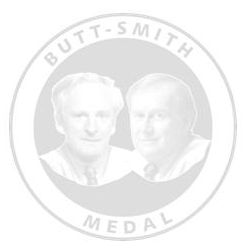
The medal recognises and honours the significant contribution of Charles Butt and Ray Smith to research and development related to the mineral industry in Australia through their lifelong association with CSIRO and CRC LEME. The work they pioneered in the early 1970s and developed with colleagues is widely credited as having contributed to several successful exploration programs in the 1980s and 1990s.
The Butt Smith Medal is awarded every two years and attracts a $15,000 grant. The recipient gives a Commemorative Address on the scope of his/her work, and other presentations on opportunity around Australia. It is open to geoscientists who have made an outstanding and sustained contribution linking regolith science to exploration in Australia. The inaugural Medal was won by Dr Richard Mazzucchelli in 2004. See LEME Archive News September 2004 for full detail.
For further information contact either:
Steve Harvey (CSIRO) - email
or
Steve Rogers (CRC LEME) - email
December 2005
Study Shows CRC Programme boosts economic growth in Australia by $1.1b.
November 2005
Chinese CHIM and the search for buried wealth
Electro-geochemical "CHIM" techniques developed by Chinese researchers are undergoing trials in collaboration with LEME researchers in South Australia to assist in the search for buried mineral deposits. (LEME Curnamona Minex Project, Program 1). FULL STORY - CLICK HERE
Winning IGES Posters
LEME researchers win First, Second and Third Awards for the BEST PROFESSIONAL POSTERS at the 22nd IGES held Sept 05 in Perth. FULL STORY (and to view the posters) - CLICK HERE
- Using groundwater to vector towards mineralisation under cover: the Curnamona Province.
- Soil and biogeochemical signatures of the Aripuana base metal deposit - Mato Grosso, Brazil.
- Mineral hosts for gold and pathfinder elements at the Mount Gibson and Lacefield gold deposits, WA.
October 2005
CHANGE OF CEO FOR LEME
Dr Steve Rogers will take over from Dr Dennis Gee on 10 October. FULL STORY - CLICK HERE
Dr R Dennis Gee retires
The Board of CRC LEME accepted Dennis Gee's decision not to renew his contract on expiry, with regret. At the Board Dinner held 8 September, Board Chair, Mr George Savell, iterated the Board's view that Dennis has served the CRC with dedication and will hand over a fine-tuned and efficient operation.
Dennis plans to take semi-retirement to pursue other interests of both a professional and personal nature. It is expected that he will retain some connection to LEME and CSIRO Exploration and Mining as he develops some of these interests.
September 2005
TWO NEW HONORARY FELLOWS OF LEME
At the LEME Board Dinner held 8 September 2005 in Perth, two new Awards were made, by Board Chair Mr George Savell, in recognition of outstanding contributions to the development and promotion of regolith geoscience. These were to Dr Ray Smith and Prof Gerry Govett. Full details of these and previous Honorary Fellow Awards.
Ray Smith
Gerry Govett (left), Dennis Gee, George Savell
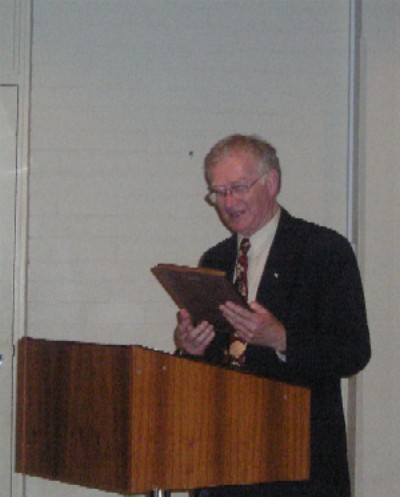
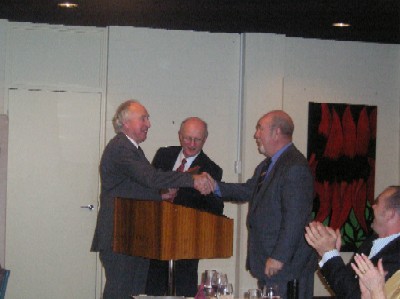
June 2005
Congratulations to Baohong Hou who has been awarded a 2005 Churchill Fellowship
- from the Winston Churchill Memorial Trust "rewarding Australians striving for excellence"
Baohong Hou who is a LEME in-kind geologist with PIRSA, now has several credits to his name. Baohong and his colleagues have been complimented by Iluka Minerals for their palaeographic reconstructions of the Eocene shorelines of the Eucla Basin, which played a significant part in the recent discovery of the Jacinth heavy mineral sand deposit in South Australia. Then he was instrumental in getting up an IGCP project called Continental Fluvial Palaeosystems - Evolution and Mineral Deposits . In May-July 2004, Baohong undertook a exchange lectureship with five Chinese universities to speak on regolith work in Australia, and learn of CHIM electro-geochemical techniques in China.
Baohong will use his fellowship to interact with colleagues in US, Canada and Russia on palaeodrainage and electro-geochemical techniques of exploration through cover. Baohong will probably travel in the second half of 2006.
May 2005
DR ANNAMALAI MAHIZHNAN - HIGHER 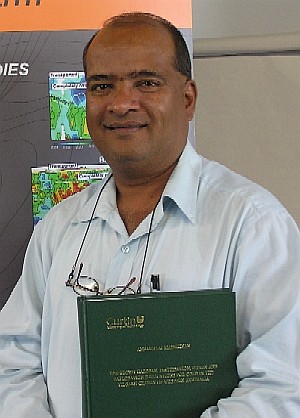 DEGREE RESEARCH PRIZE DEGREE RESEARCH PRIZE
Dr Annamalai Mahizhnan (known as Anna to his LEME friends) was awarded the Curtin University of Technology KRISHNA AND PAMELA SAPPAL PRIZE 2004 for the best Higher Degree Research Graduate in Geoscience.
Anna was a LEME Scholarship student and his PhD thesis was "Red brown hardpan distribution, origin and exploration implications for gold in the Yilgarn Craton of WA"
Congratulations Anna.
RIVERINA GEOCHEMICAL SURVEY
Collaborative project between CRC LEME and Geoscience Australia. First report on low-density geochemical surveys in Australia. Refer to AusGeo News Issue 78. June 2005.
Such surveys have not taken place here before, for a variety of reasons, and this first pilot project, in the Riverina region, outlines and tests a methodology adapted to Australian conditions. Geochemical surveys have a multitude of potential applications for
- natural resource management,
- mineral exploration and
- geohealth/environmental health risk assessment.
Please do not hesitate to give Project Leader Patrice de Caritat your feedback on this pilot project, as others are under way, and we are keen to collaborate with other state, federal, academic and international research organisations.
GUMTREES AND MULGA: SIGNPOSTS TO MINERALS
CRC Association Media Release, May 2005
|
